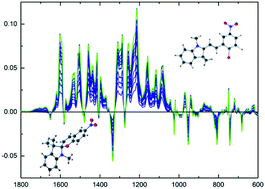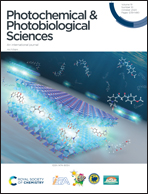Tracking the light-induced isomerization processes and the photostability of spiropyrans embedded in the pores of crystalline nanoporous MOFs via IR spectroscopy†
Abstract
The embedment of photochromic dyes into porous host matrices has attracted increasing interest in recent years. Especially the class of spiropyrans has been considered because of its outstanding photochromic and solvatochromic response. We herein present a comprehensive infrared spectroscopic characterization of the photoresponse and photostability of a nitro-substituted spiropyran “SP-Nitro” (namely 1,3,3-trimethylindolino-6′-nitrobenzopyrylospiran) non-covalently attached to different crystalline nanoporous MOF (metal–organic framework) host lattices. The TTC mesomeric form of SP-Nitro has been found to be preferably generated upon UV light exposure inside the different MOF hosts. Additionally, the excited isomer was found to be stable for prolonged irradiation times of 1–1.5 h.



 Please wait while we load your content...
Please wait while we load your content...